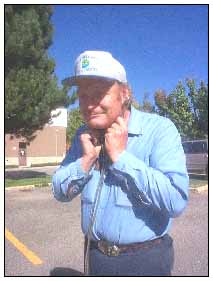Bulletin Board
The Water Doctor
October 19, 1999 Ken Schiess has been working for the Salt Lake City Department of Public Utilities for 17 years. Using his Metrotech 8-10 instrument he can be found at all hours
listening through his earphones locating water, sewer and stormwater pipes buried deep in the earth. Locating utility lines is critical and necessary in order to avoid damage during
construction activities. The utility corridors under each street are packed full of various utility facilities -- and it's getting more crowded every year as more utilities are installed within the public streets.
Besides water, sewer and stormwater utilities, there are electrical, gas, communications, street semaphore wires and cable television that require maintenance, replacement or new installations as service
levels increase. Since there is constant work within the corridors, it's necessary to locate the facilities before work begins. Under the "Blue Stakes" program each
utility is required to locate their facilities and mark them before the excavation can be started. Another important part of Ken's work is to locate leaking pipes. Many surface
but others disappear through the sub-soil. Controlling lost water through leak detection is an important utility program. Water lost through leaks is a resource and revenue lost to the utility.
Ken says the procedures remain the same, over and over, but experience has sharpened his skills. "I'm better today than I was when I first got started," he
explains, "experience is the best trainer, and time on the job is the best way to gain the experience." Ken believes that the challenge is "dealing with something
you can't see and relying on your ears to search out the location." Water is the most difficult because it's one of the deepest utilities. Ken says, "it's more difficult
to get an exact location of water lines that are 4 to 5 feet deep." But he feels that if he comes close enough to have the pipe in the middle of the excavation, he's done a good job.
There are two ways of using the Metrotech 8-10. Either in the "inductive mode" where the instrument induces a signal into the ground and he is able to locate the
pipe. The second method is by physically connecting a wire to a reference point, such as a fire hydrant, valve or water meter. The signal flows through the
reference point to the pipe for location. The technology actually was developed by the military during World War I when military activity by the enemy could be
heard through the earphones. Its use in the utility business is less ominous and provides an important tool peacetime. The headset looks much like a doctor's stethoscope. With his headphones on K
has been asked by passing children what he is doing. He replies with a grin, "I'm the water doctor." When he's listening to a water leak, Ken likens the sound in his
earphones to the sound a doctor hears when examining a patient's heartbeat. Both the children and he get a kick out of his response "that he's seeing if the hydrant is sick".
Ken is the senior locator. For much of his career he was the only locator, or one of two. But several years ago, the State Legislature required all public water and
sewer utilities to join Blue Stakes. In order to handle the daily average of 100 locations, there are now seven locators on duty. August is the peak month for
locations with between 150 - 170 location slips. Each Locator is assigned an area and rotated every 6 months. The Salt Lake City Department of Public Utilities is the largest water, sewer and
stromwater utility in the Intermountain West. The water utility serves nearly 90,000 connections through 1,358 miles of pipe. The sewer utility has 48,000
connections and 611 miles of pipe. There are 433 miles of buried stormwater pipes. System maps are important in performing his job. He likes the old microfilmed
maps, but the department is going to Lap Top computers for fieldwork. He'll miss the microfilm, but is ready to change with the new technology.
The most dangerous part of locating is traffic. Over the years traffic has dramatically increased. "Sometimes it's necessary to block off a traffic lane on a
busy street, but I try to avoid this as much as possible," says Ken. There is concern over being hit. "Its necessary to concentrate on the sounds in the
earphones, but on the other hand it's necessary to pay attention to the traffic. It takes discipline to do both. You really have to be careful" he exclaims. If the
traffic is very heavy or there is a lot of noise, Ken will make the location in the early morning. He likes 3:00 am. However, once a nervous resident called the
police, reporting a stranger in the neighborhood. "Not only is it safer in the early morning, the absence of noise is helpful in making accurate locations," he explains.
Ken enjoys his work. He feels a sense of accomplishment when he uses his special skills and besides, he's the water doctor! 